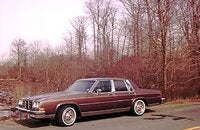What happens to the smog pump on my 73 Buick w/o connected vacuum hose?
Asked by froeschl Nov 27, 2021 at 11:20 AM about the 1973 Buick LeSabre
Question type: Maintenance & Repair
What happens to the smog pump on my 1973 Buick Centurion when the vacuum control hose is no longer connected to it (see attached photo)?
Got a vacuum problem with my car that was fixed few days ago. Solution of the auto repair shop was to remove some vacuum hoses such as the one that was routed to the smog pump. Can I live without it?
6 Answers
The A.I.R. (Air Injection Reaction) pump aka "smog" pump forces fresh air into the exhaust manifold to continue the combustion process as the exhaust gasses leave the engine. The diverter valve, which is the gizmo that the vacuum hose is hooked up to, regulates the amount of fresh air that goes to the exhaust manifold based on engine load and engine RPMs. As the engine load and RPMs change so does the amount of vacuum going to the diverter valve. Not having the system hooked up and operating correctly will increase exhaust emissions and, in some cases, cause the engine to backfire violently, like a shotgun report, out the tailpipe a few seconds after the engine is turned off. This will damage the exhaust system in addition to be very annoying and embarrassing. My advice is to get a factory shop manual for your Buick and hook up the vacuum hoses correctly! You should also consider finding another mechanic who is older and more familiar with your vintage car. Hope that helps! Jim
Thanks Jim for your answer - even if I still don't understand how blowing fresh air into the exhaust system can improve the emissions. Diluting the exhaust gases with fresh air does not make much sense to me ;-) Greetings, Peter
Hi Peter, your welcome. Glad to help. The idea behind it is that you need oxygen (air) for combustion. So injecting air into the exhaust manifold enables any unburned combustible gases to burn off in the exhaust manifold as the exhaust leaves the engine. The violent backfiring that I explained previously happens because those unburned gases ignite in the exhaust system from the heat of the exhaust system immediately after the engine is shut off and the exhaust system is still very hot. This backfiring can also occur on deceleration when the engine slows down and the exhaust is moving more slowly through the exhaust system. In the early days of the A.I.R. systems the diverter valve was also called the "antibackfire" valve for that reason. The opposite is true in a more modern vehicle with an electric fuel pump. Back in the 80s when you began seeing more and more vehicles with electric fuel pumps in the gas tank my question was aren't they dangerous? What if there's a spark in the gas tank? Won't the vehicle blow up or at least catch on fire? The answer is no. Because there's no oxygen in the gas tank, only gasoline and gasoline fumes, so combustion can't happen. You need air for a fire or explosion to happen. Hope that helps you understand the workings of the smog pump system in your Buick. Jim
Gotta love those 1970's technologies! It was a good idea for that decade. Get a routing diagram and hook it back up!
Jim, you made me understand the real purpose of that smog pump! For the first time in my life I got it!! Thank you so much!!!
You're welcome, Peter! So glad to hear that! Happy to help! Thank you for the best answer click too! Jim

